EBOOK
The State of Customer Journey Optimization
Published: Oct 18, 2019
What’s the state of Customer Journey Optimization (CJO) heading into 2020? In this report you’ll find out what more than 200 e-commerce professionals have to say.
Executive summary
The State of CJO is an annual report seeking to understand how e-commerce marketers are optimizing the online customer journey. Now in its second year, this edition* examines the current state of customer journey optimization (CJO) compared to 2018, and reveals marketers’ plans for 2020.
Here are some of the key findings:
- 2019 was the year marketers cracked CJO, overall demonstrating a greater level of satisfaction with their understanding and optimization of the customer journey compared to 2018.
- The area of CJO that was ‘most improved’ was ‘optimization of customer journeys across multiple channels’, which was up over 25 percentage points, to 88%.
- These high levels of satisfaction were aligned with a much greater level of confidence (>90% confident or very confident) in defining CJO as a standalone practice in relation to more established optimization methods such as CRO and Personalization.
- The biggest challenges facing marketers have shifted away from tools and technology toward people and processes, particularly finding talent with the right skills in the UK and Retail.
- Privacy is also a growing challenge, almost doubling in importance versus 2018, particularly affecting travel and US marketers.
- Marketing automation is on the rise as a CJO tool. While personalization and customer feedback are still among the top tools and strategies, Marketing Automation saw the biggest gains, now the top used tool.
Read on to discover the state of CJO, the biggest challenges, and 2020 CJO plans, each broken down by vertical and market.

*Methodology: This research was conducted by Censuswide, an independent market research consultancy, with 207 UK and US ecommerce marketers who work in retail and travel: 100 in the UK and 107 in the US. Fieldwork was carried out between 11.09.2019 – 17.09.2019. Censuswide abide by and employ members of the Market Research Society. All survey panellists are double opted in, which is in line with MRS code of conduct and ESOMAR standards.
The State of CJO 2019
What’s the state of CJO in 2019, and how has it changed since 2018? In this first section we’ll explore how satisfied marketers are with their understanding of customer journey optimization, the tools and strategies they’re currently using, and the results to date.
The State of CJO 2019: The year marketers cracked customer journey optimization
What stood out most from this year’s results, especially when taken in comparison to 2018, was the level of satisfaction marketers now have with their understanding and optimization of the customer journey. We saw significant shifts, particularly in the optimization of customer journeys across multiple channels, which was up to 88% versus just 62% in 2018.
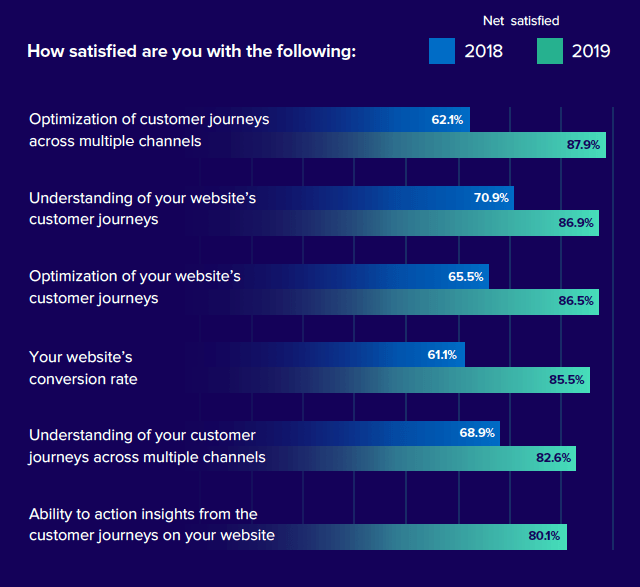
Other areas of improvement included conversion rate, with 85.5% of marketers now satisfied or very satisfied, suggesting that traditional conversion rate optimization (CRO) tactics have become table stakes.
This improvement in satisfaction is perhaps linked with the fact that CJO is becoming much more of a defined practice. Marketers were much more confident defining it in relation to Personalization and CRO than last year:
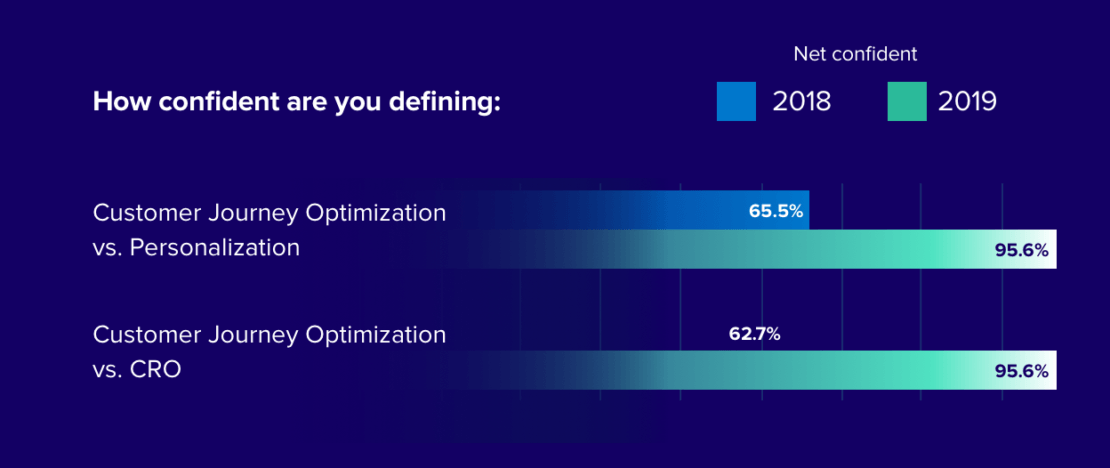
We also see these advances in understanding reflecting in the tools and strategies marketers are using in 2019 to optimize the customer journey. Last year’s top tools were simpler: customer feedback and customer journey mapping, both essential for understanding the customer. In 2019, marketers have moved on to actioning the insights they’ve gathered.
The top tool in 2019 is marketing automation, followed by website personalization and multivariate testing (MVT). The latter two were ranked among the most difficult to implement in 2018’s survey, and the ‘easy’ tools and strategies that dominated last year’s survey (customer feedback, customer journey mapping and usability testing) have moved down in priority, indicating how far marketers have come in a short time when it comes to tackling CJO.
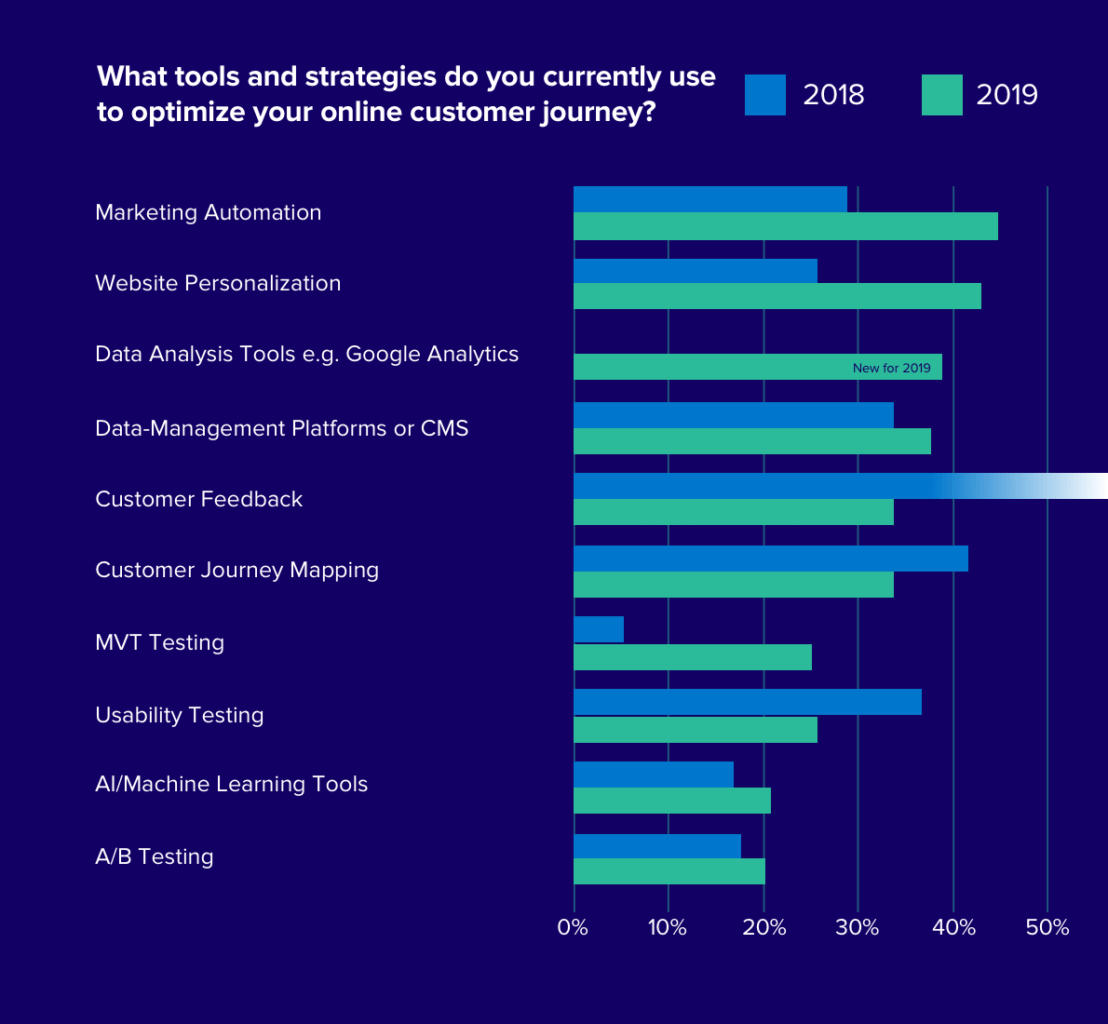
The State of CJO 2019: Travel and Retail take different approaches
As well as analyzing the overall trends, we looked at the differences between retail and travel. Both industries have different customer journeys – does this result in a different approach?
While overall satisfaction across retail and travel was pretty similar, there were a few areas where travel marketers were more likely to be ‘very satisfied’ compared to their retail counterparts. First up, conversion rate:
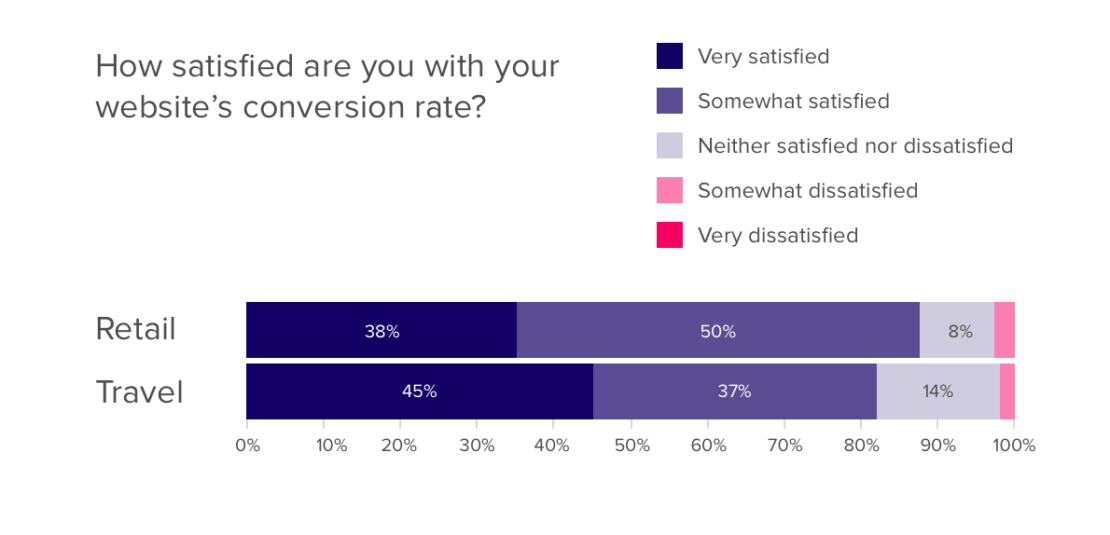
While retailers had a higher level of satisfaction overall, with 88% either somewhat or very satisfied, travel marketers were more likely to be very satisfied (45%).
This is backed up by the fact that travel marketers were more likely to be very satisfied with their ability to action insights:
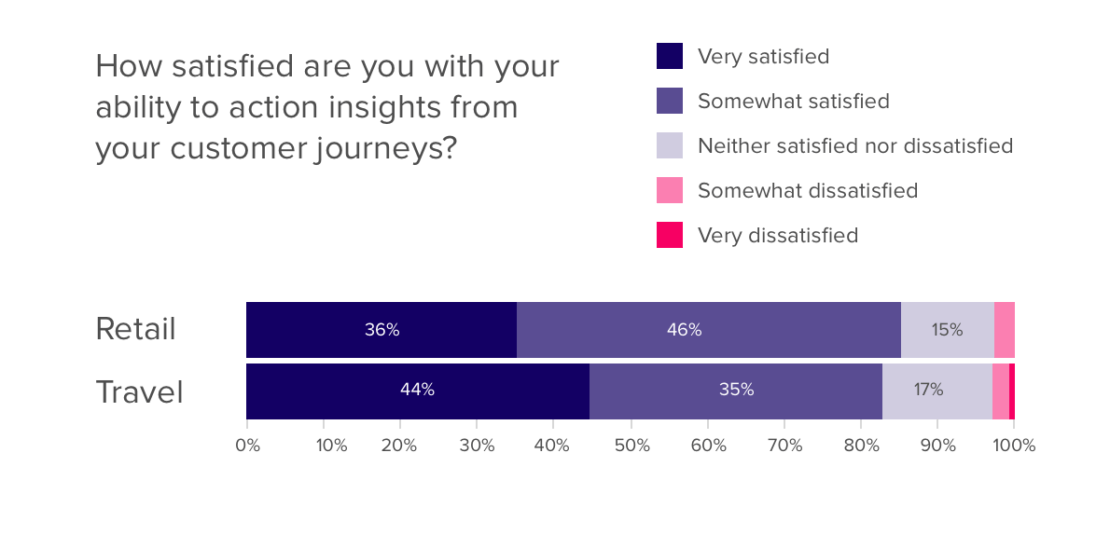
So that leaves the tools and strategies each group are using to optimize the customer journey in 2019. Here is where we started to see some more differences emerge:
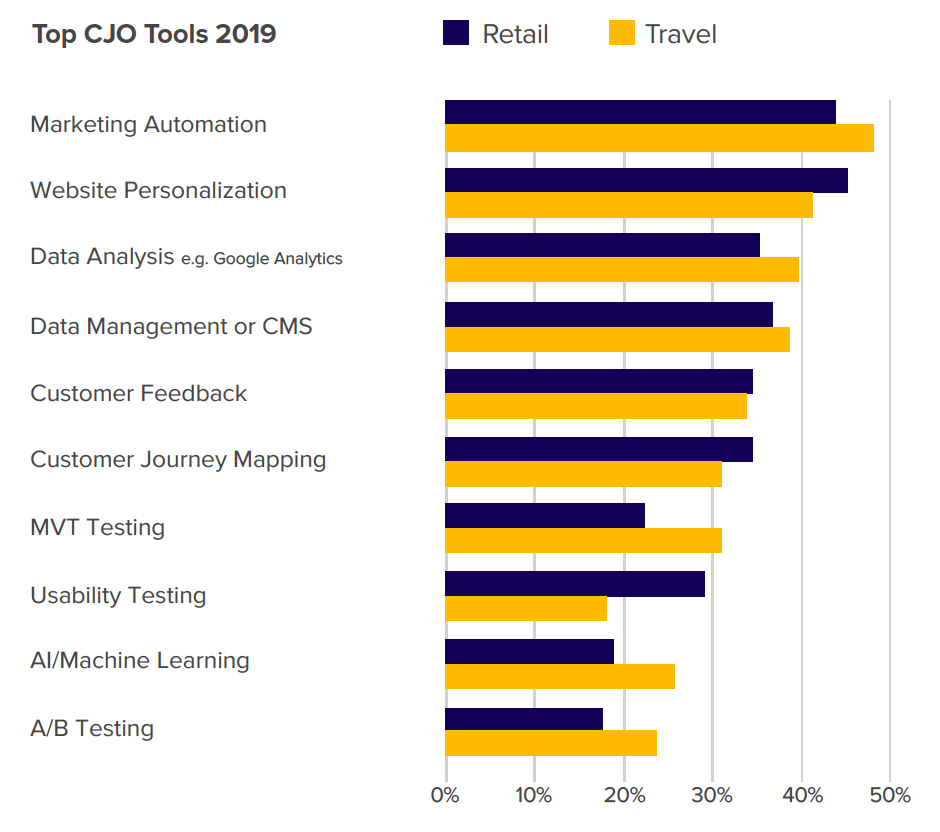
While both groups are focusing on marketing automation, travel is much more likely to be doing so. Travel’s other focuses fall in line with this trend toward automation – they are much more likely to be using AI and Machine Learning. The other area of difference is testing – travel are more likely to be running MVT and A/B testing programs.
Where travel marketers are busy testing and automating, retail marketers are more likely to be using tools focused on understanding the customer journey (customer journey mapping, usability testing) and improving the customer experience (website personalization).
This difference in focus when it comes to CJO i.e. executional vs. analytical, perhaps explains the levels of satisfaction we noted at the start of this section.
The State of CJO 2019: US marketers catch-up, while UK proceeds with caution
When it comes to satisfaction levels with CJO efforts, the UK and US were broadly similar. Both were largely satisfied with their conversion rate and the understanding of the customer journey. There were a few areas where US marketers expressed greater levels of satisfaction than their UK counterparts:
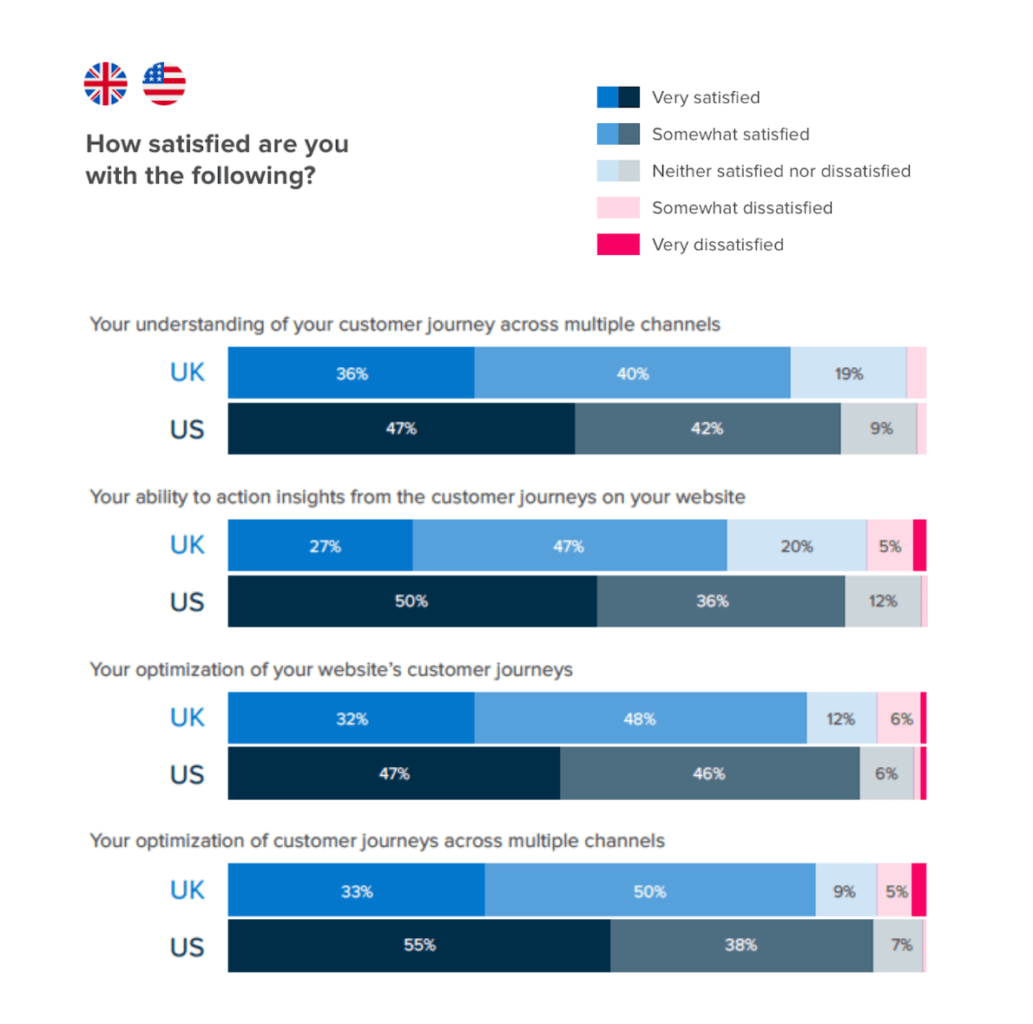
Compared to 2018, this represents quite a change – last year, US marketers were less satisfied than their UK counterparts. Again, multichannel is where this is particularly evident – last year over a third of US marketers were dissatisfied with their multichannel CJO efforts, compared to 16% in the UK. This year the levels of satisfaction are much higher.
Finally, can we understand the differences in satisfaction based on the tools US and UK marketers are using to implement CJO? While again, marketing automation and website personalization were among the top-rated strategies, the US put a greater focus on them:
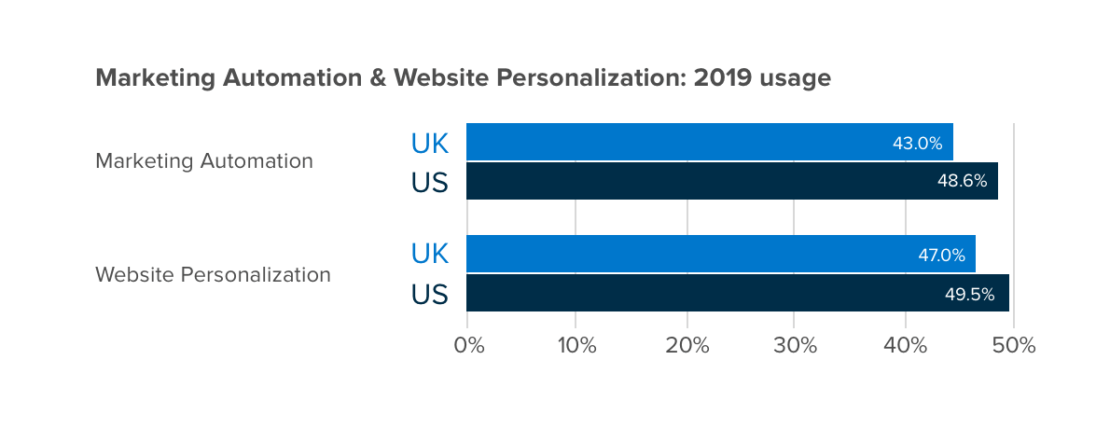
The US was also more likely to be using AI and testing methods, while UK marketers put a greater focus on data analysis and data management – perhaps in response to the implementation of data privacy legislation such as GDPR in the EU.
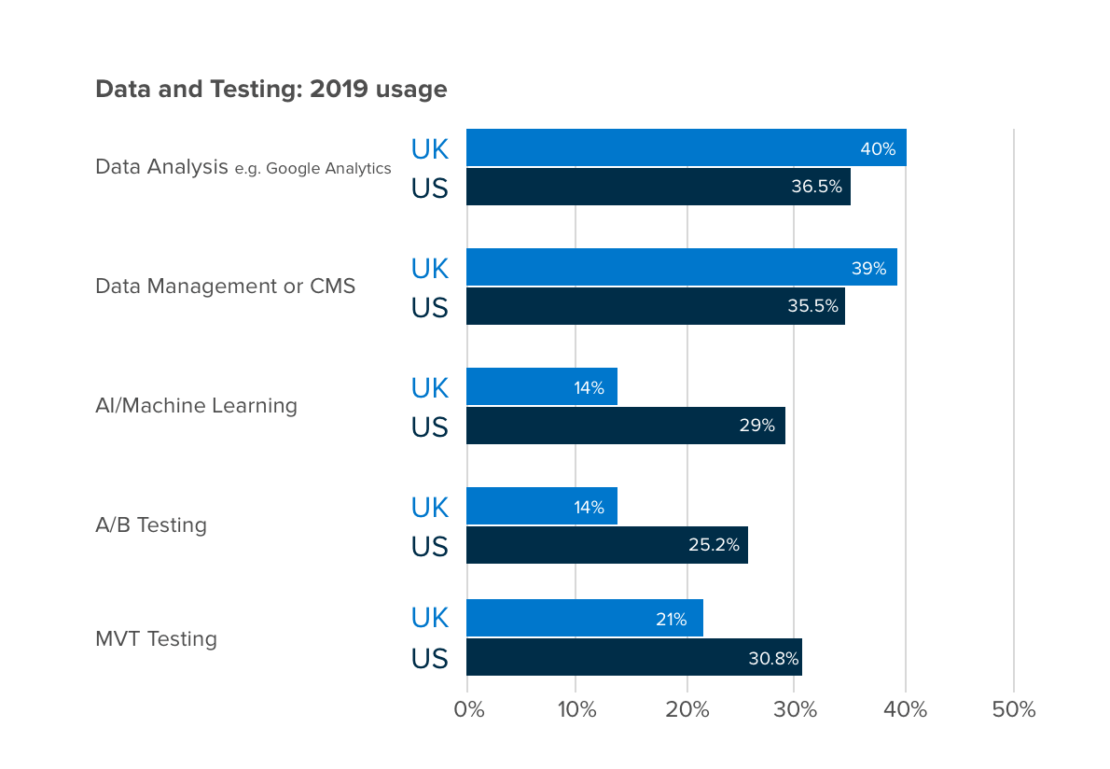
The State of CJO Challenges
What are the biggest challenges facing marketers when it comes to delivering an optimized customer journey?
The State of CJO Challenges: All change when it comes to customer journey challenges
In the last year, we’ve seen a major shift in CJO challenges from tools and processes towards skills and people. It seems that many marketers have now got their houses in order when it comes to their technology stack and established a CJO program, but this itself has presented fresh skillset challenges.
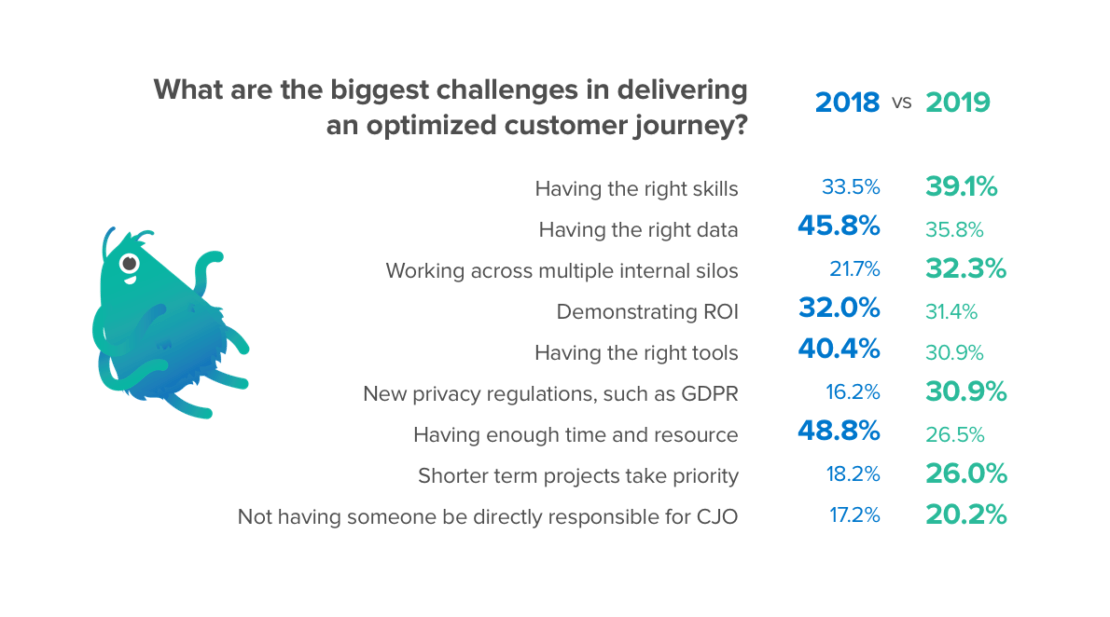
Sourcing people with the skills required to make sense of customer journey optimization efforts and drive CJO forward is now the top challenge overall, where in 2018 this was ranked the 4th biggest challenge. Underscoring this is the fact that having the right tools, previously ranked 3rd, now drops to 5th place.
2019 has also seen a growth in internal silos as personalization and customer journey optimization increasingly touch multiple parts of the business. Nearly a third of marketers (32.3%) rated this as a challenge, rounding out the top three along with having the right skills (#1) and right data (#2).
Interestingly, despite the dawn of GDPR since the last survey, and the fact it holds on to the #2 spot, having the right data is now challenging fewer marketers – 35.7% ranked it a challenge versus 45.8% in 2018.
The State of CJO Challenges: Retail skills shortage and privacy problems for travel
When it comes to the challenges retail and travel are facing individually, we see a few differences:
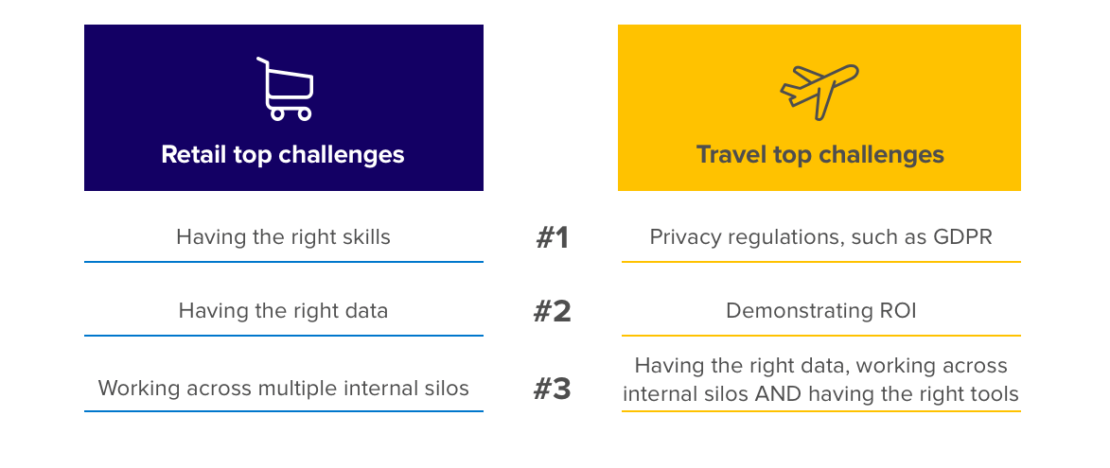
As the digital skills gap continues to widen, retailers are facing a skills shortage, and this is impacting the delivery of CJO. This is also evident in the fact retailers were more likely to see time and resource as a challenge (31%) compared to travel (19%).
In travel, the biggest issue is privacy – this aligns with research released earlier this year that found travel was the industry most struggling to recover its databases one year on from GDPR. Compared to retail, 38% of travel marketers rated this as a challenge, versus just 26% retailers, and 31% overall.
While retailers reported strong recovery in terms of email databases post GDPR, having the right data to deliver CJO was actually rated the #2 challenge. This suggests there is a need within retail particularly to move beyond basic lead capture strategies, toward a more granular understanding of visitors, utilizing behavioral and contextual data rather than relying on private data.
Finally, worth mentioning is the greater challenges travel marketers are having with demonstrating ROI, with 36% putting this in the #2 spot. For retailers this was less of a worry, coming in #6 overall at 28%. This is perhaps due to the complex, fragmented and lengthy nature of travel customer journeys versus retail ones, making tracking success difficult.
The State of CJO Challenges: UK and US mirror vertical CJO trends, but not as expected
Skills and privacy were again areas where the segments – this time markets – diverged. The US was unexpectedly perhaps, a lot more concerned than their UK counterparts about privacy regulations impacting CJO. This is perhaps due to the fact that the UK has already experienced GDPR, and had to get processes in place as a matter of business urgency:
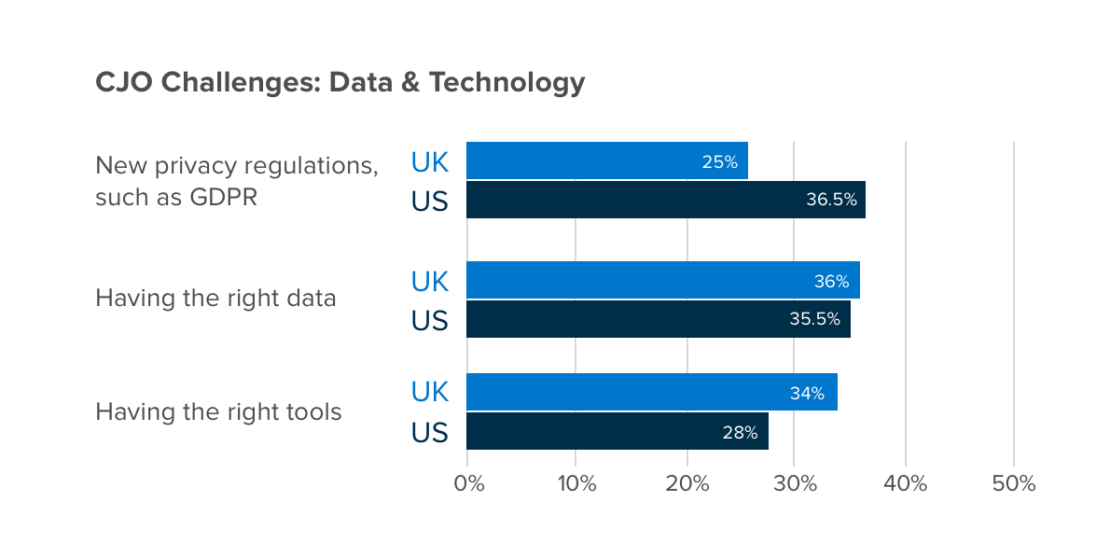
As new privacy regulations such as the California Consumer Privacy Act (CCPA) come into effect from January 2020, the time has come for US marketers to ensure privacy is a foundation of their CJO strategy.
When it comes to matters of skills and people, both markets are under pressure but in different ways:
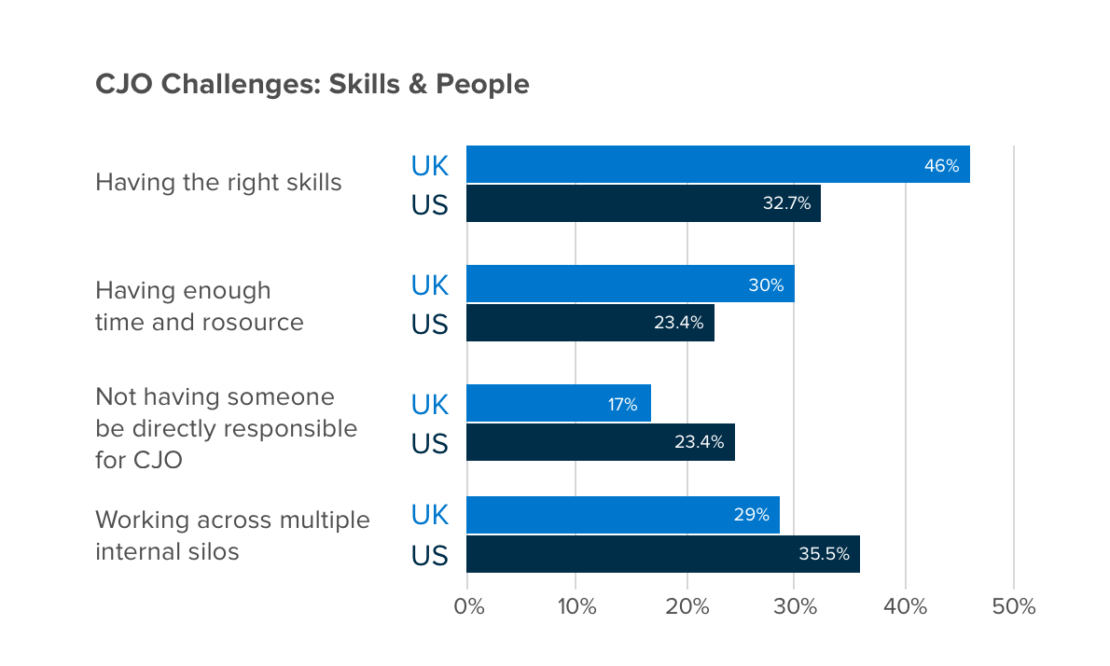
The UK is facing a major skills shortage, which will likely not be helped by geo-political issues such as Brexit. Related to the skills shortage is a real pressure on time and resources, with 30% rating this as a challenge versus 23% in the US. Where the US does have issues is in ownership of CJO, and by extension the problem this raises with working across internal silos.
Finally, like our travel marketers, the US marketers have money on their mind. There was a much bigger concern about demonstrating ROI with 35% seeing this as a top challenge, versus just 28% in the UK.
The State of CJO 2020
In this final section, we seek to understand what’s in store for CJO over the next year including the tools marketers will use and where they plan to invest budgets.
The State of CJO 2020: Marketers shift resources and evolve strategies to ensure CJO success
The biggest takeaway from our data was that CJO is now very firmly on the agenda. Now that marketers seem to have cracked their strategy, 2020 will be the year they work to refine this and ensure everything is in place for success. At the start of 2019, 15% of marketers had no plans to work on CJO – this is no longer an option, with just 1% saying the same going into 2020.
So what will marketers be doing, and how has it evolved to meet the new CJO challenges? Here are the top five:
1. The right tools for the job
As we’ve already explored, having the right tools for CJO is now seen as less of a challenge – however, it’s an area where marketers will continue to make investments heading into 2020. Planned investment in dedicated tools and solutions jumped up from 21% to 49%, demonstrating how important the right tech is to a successful CJO strategy
2 & 3. The right people to drive CJO
As we saw in section 2, skills and training will feature more heavily going into 2020 – 46% will train their existing team (up from 34%), and 40.5% will hire more specialists (up from 23%). Marketers know they need to invest, but finding the right talent will be the challenge.
4. Increasing budget dedicated to CJO
While budgets are still important, this actually fell down the rankings from last year, where it was the #2 priority. This suggests that marketers may have had more luck in securing the budgets needed, or are diverting this more purposefully toward people challenges.
5. Working with consultancies/agencies
This too has been squeezed out of the top three by internal people issues (last year it was #3), but still more than one third will choose to work with consultancies and agencies in 2020 – a wise choice perhaps given the skills shortage challenge.
So, given that marketers are planning to invest in more tools and technologies, where will this budget be spent?
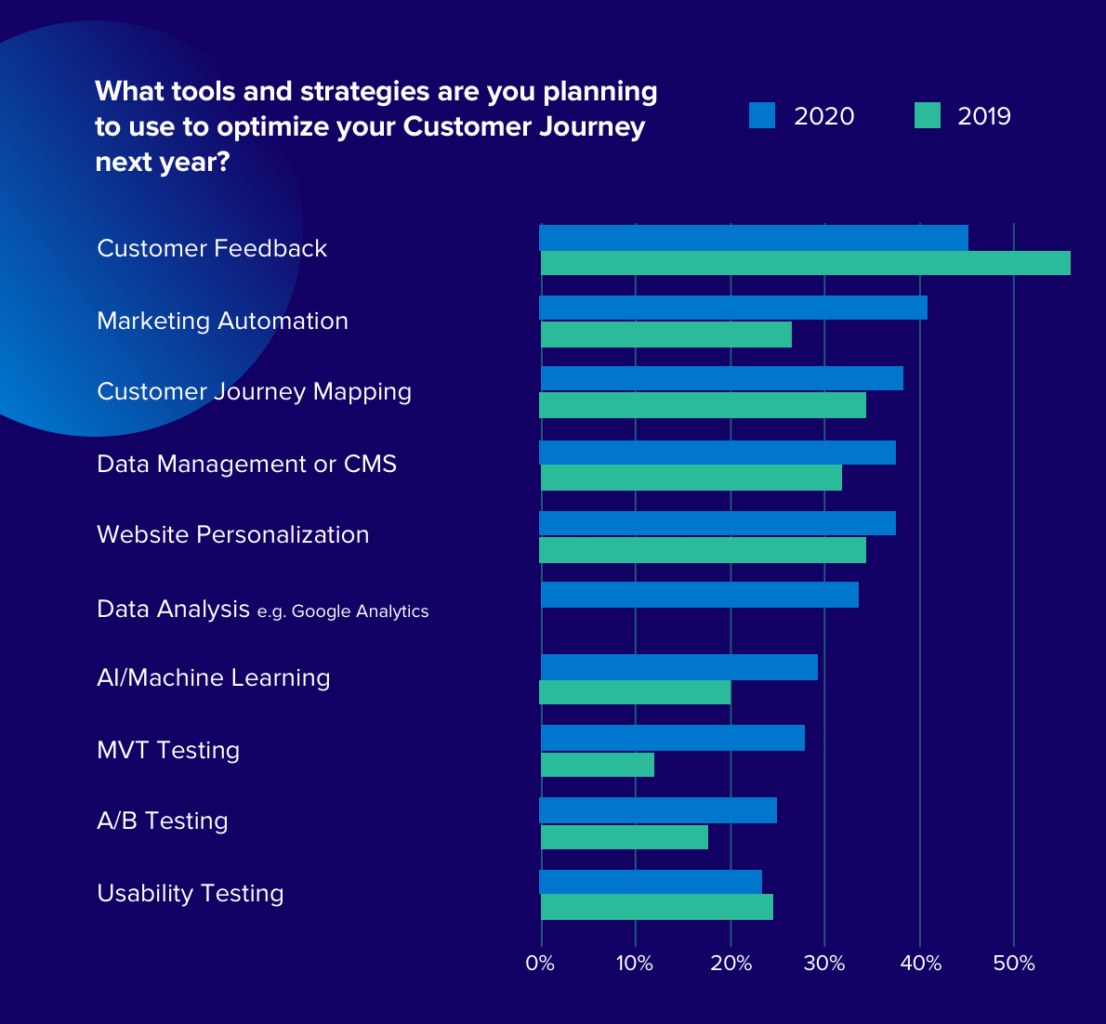
As we can see, customer feedback is still the top strategy that marketers will rely on, but less so than in 2019. Marketing automation has made some huge gains, now the #2 strategy with 41% of marketers ranking it a priority for 2020. We can also see a greater focus on testing and technologies such as AI and machine learning compared to 2019 plans.
The State of CJO 2020: Travel to make external hires while retail look internally
The top priority in retail is, as expected given the data we’ve seen earlier in the report, is on training and hiring to fill the skills shortage. In travel however, this focus will be external:
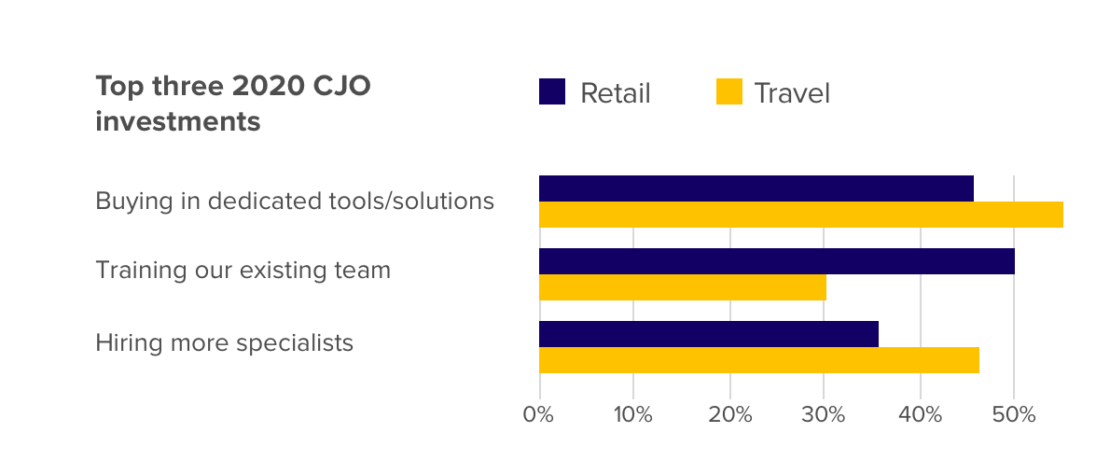
The tools and strategies travel and retail will invest in next year broadly align with the overall trends, but with some notable differences.
Travel will focus more on customer journey mapping – this was tied as the top tool or strategy for 2020, along with customer feedback and marketing automation. Again, this is likely related to the more complex and fragmented nature of the travel customer journey.
Data management and personalization are much bigger focuses for retail, rounding out the top three alongside customer feedback.
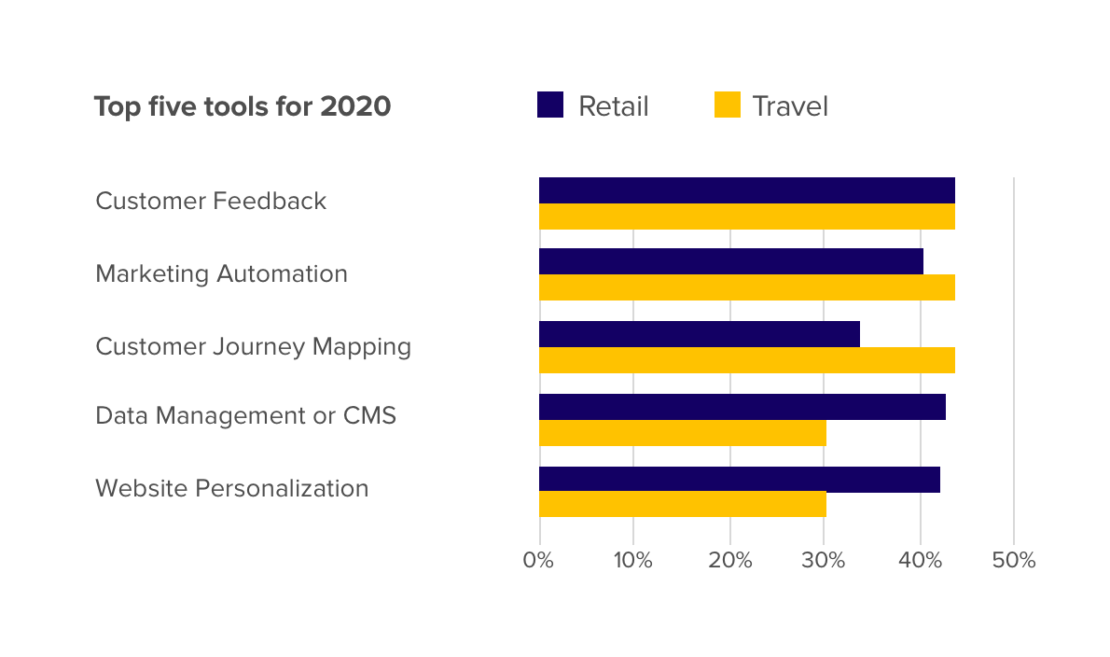
The State of CJO 2020: UK will outsource, while US hires specialists
In contrast to the vertical trends, the UK and US were quite different when it came to 2020 plans for investment. The top areas in the US for investment are tools and skills – is a little surprising when remembering that skills were rated a bigger challenge in the UK. The UK seems to be planning to plug the skills gap by working with consultancies and agencies, with 44% planning this versus 30% of US marketers.
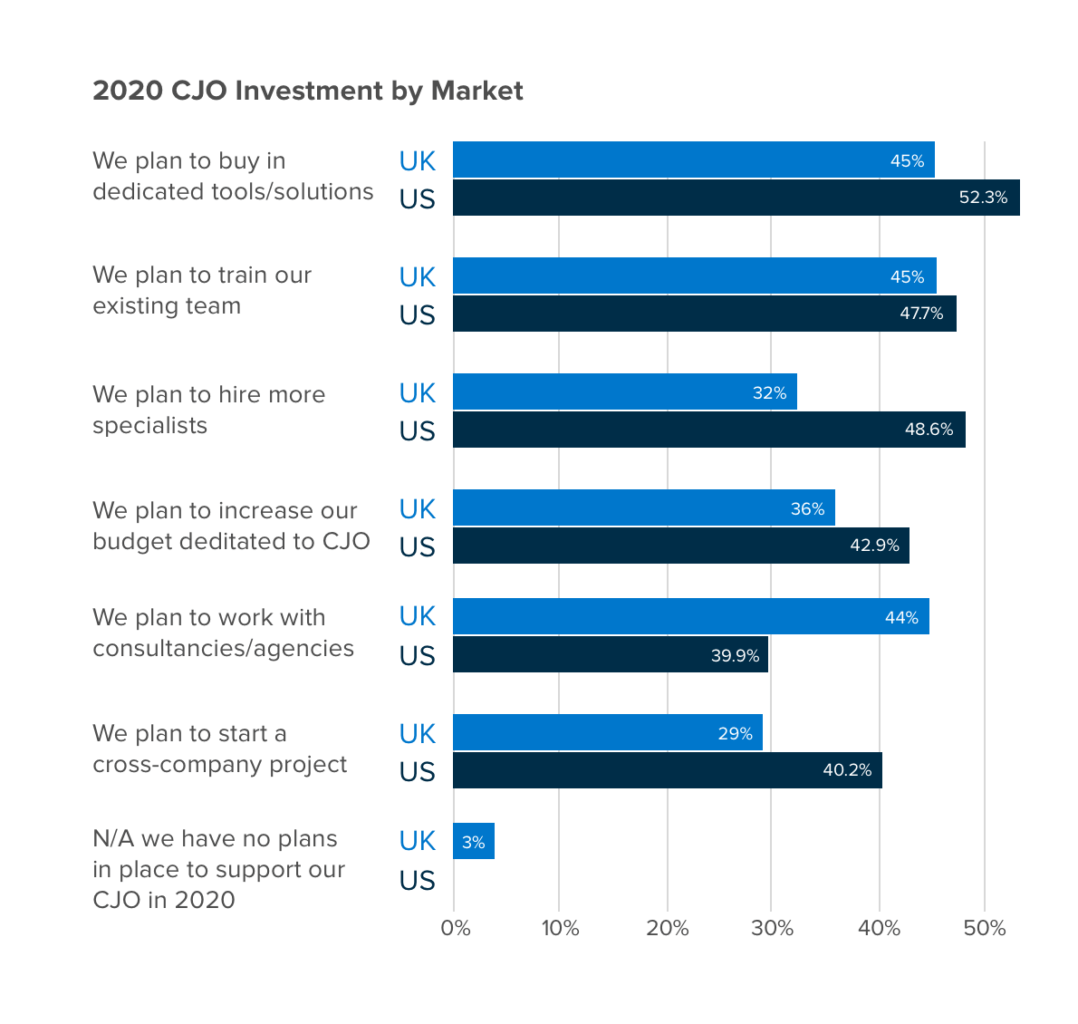
When it comes to the strategies for 2020, marketing automation came out top for the UK (47% plan to use it), while customer feedback remained a priority for the US (45% plan to use it).
Other areas where the markets diverged included personalization – this is a higher priority in the US with almost 40% planning to use it in 2020 versus 35% in the UK. In preparation for personalization, US marketers were also more focused on understanding their data via tools like Google Analytics.
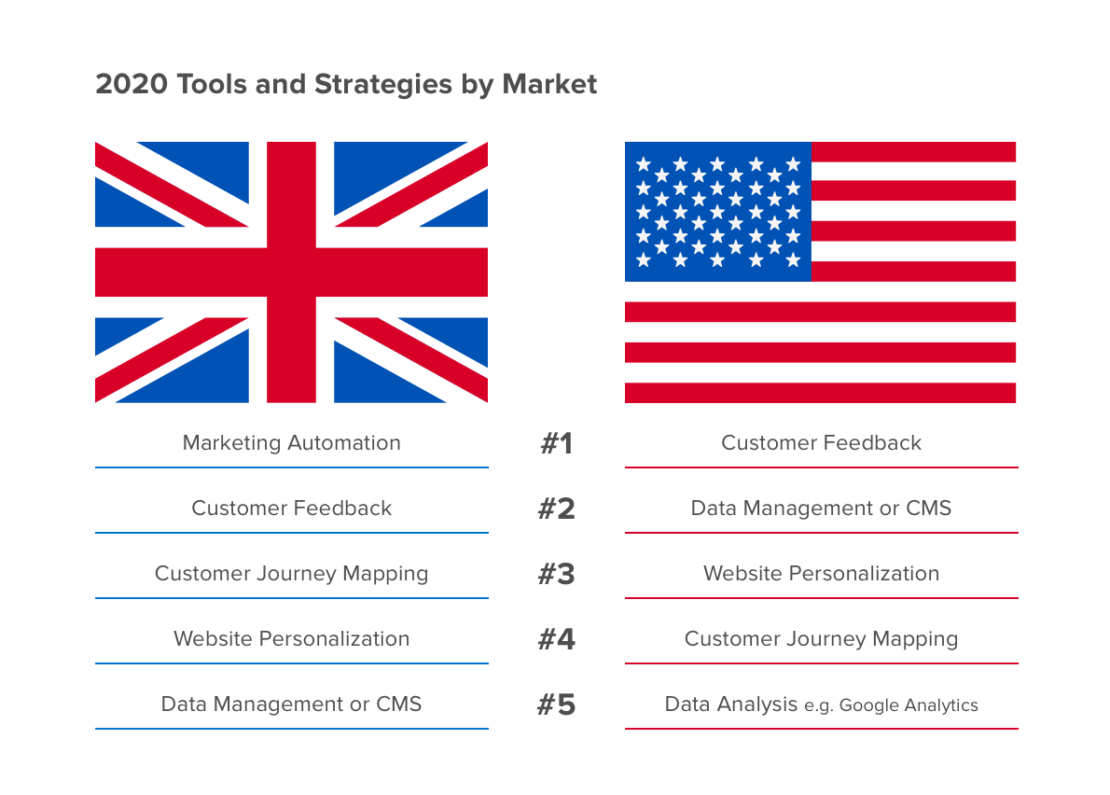
The State of Customer Journey Optimization: In Conclusion
We’ve covered a lot of ground in this report but here’s some final food for thought as you create your 2020 CJO strategy.
If 2019 was the year marketers began to crack CJO, reporting much higher levels of satisfaction with CJO efforts – could 2020 be the year marketers master CJO? There’s definitely room for growth:
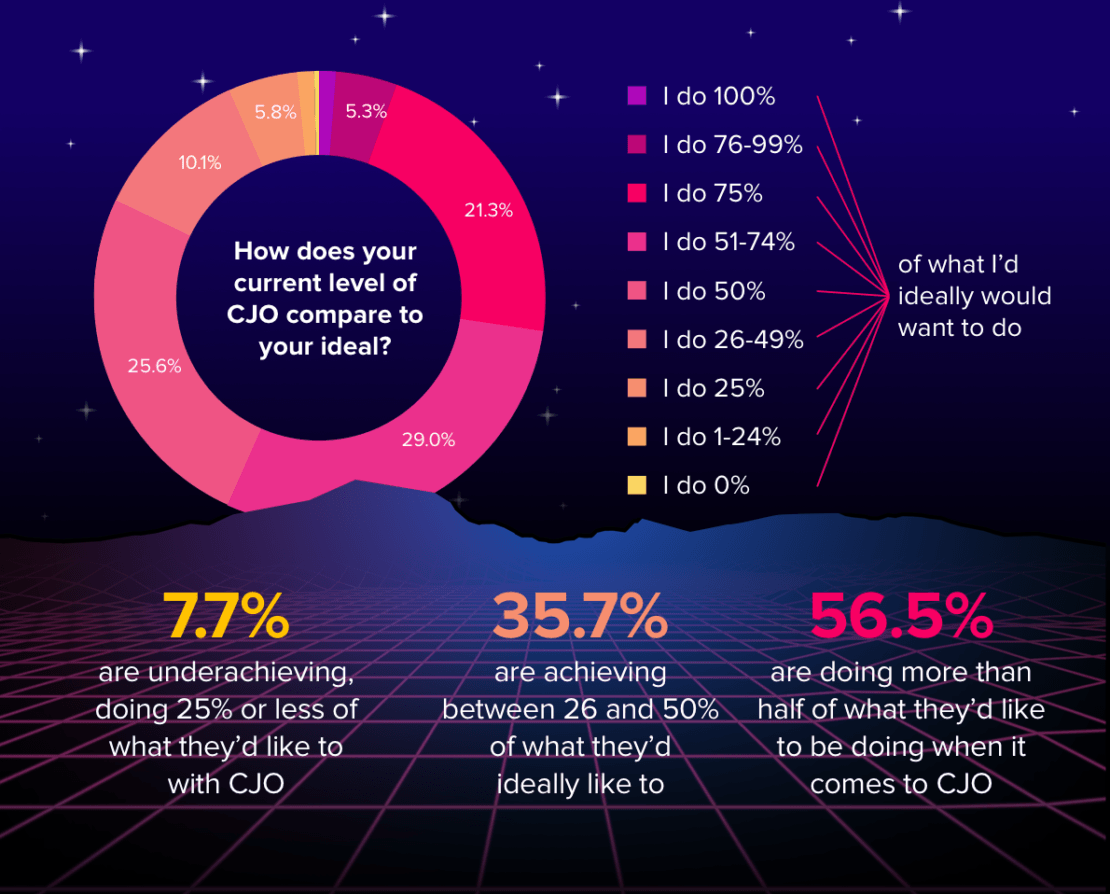
The majority of marketers (57%) are doing more than half of what they’d like to be doing when it comes to the customer journey. Just 8% are ‘underachieving’, doing 25% or less of what they’d like to with CJO. The outlook then, is good, and if planned investments pay off we’ll likely see more CJO winners start to emerge in 2020.